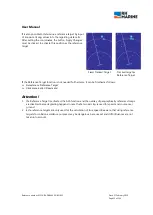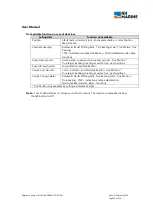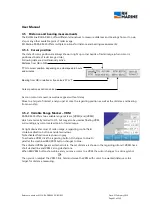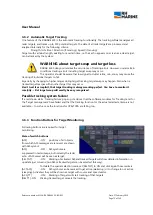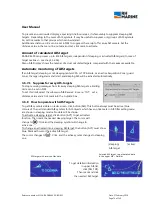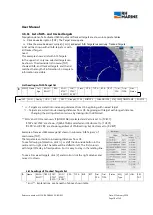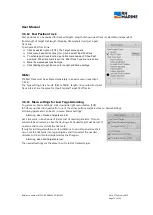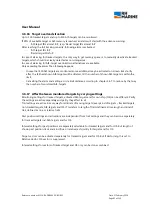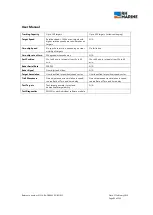
User Manual
Reference number: 4111A-RADAR4600-GBD-R1.1
Date: 27 February 2018
Page 69 of 149
3.6
Target monitoring
3.6.1
Target control dependent on picture stabilisation
When monitoring targets, it is very important to take the kind of radar picture stabilisation into
consideration: – if in sea- or in ground- stabilisation mode.
A Mariner observes a target visually and if it remains on a constant bearing to own ship, that target is
considered to be a collision threat. Same kind of observation is done by radar in its simplest form, by
selecting relative mode for radar presentation and setting an EBL onto a radar target to monitor movement
of that target in relation to own ship. If the target remains on the EBL, it is a collision risk.
Relative movement is a way to easy realize a collision risk with a single target.
The addition of a tracker function permits predictive relative vectors to be shown and if a relative vector on
the target points directly and consistently towards own ship, that target is a potential threat. Activating the
target trail function is an additional way to observe targets. If both are activated, target vectors and target
trails, also a course change of targets can be easy detected.
If target trails are shown, land will smear and buoys for example, will generate trails as own ship stays in a fix
position and therefore generates no trail.
To prevent land smear and trails of fix targets and to get control of whole target situation around own ship
it is necessary to use Stabilized Picture and True Motion mode. Then an Automatic Target Tracking is
available.
To get exact and reliable picture information, following data sources are essential:
-
EFPS, SDME and Gyrocompass.
For automatic target tracking only, speed data from a two axis log and course data from a gyrocompass are
sufficient, but significant more reliable are data from an EFPS like a GPS receiver.
The indication of AIS-targets, maps and route information are only available, if an EFPS-system is
connected.
AIS targets provide velocity over ground (COG and SOG) by using GPS or an equivalent electronic position
fixing system (EPFS). Own ship can calculate COG and SOG using the GPS VTG message. Velocity over
ground takes account of set and drift for own ship and targets. True and relative vectors may be calculated
using this information.
For special purposes, a reference target may be set, to get a stabilized picture with true motion data.
Historically, SEA stabilization is recommended for collision avoidance, while ground stabilization can be
advantageous for pilotage in coastal and confined waters.

